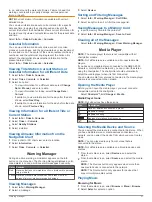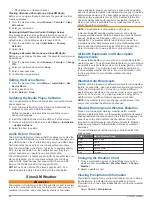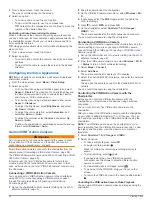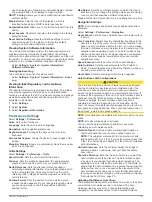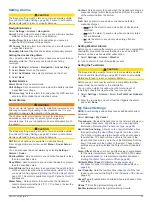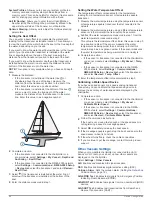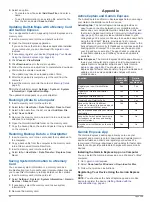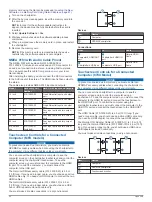
System Profiles
: Allows you to save your system profile to a
memory card and import system profile settings from a
memory card. This can be helpful for charter or fleet vessels,
and for sharing your setup information with a friend.
Hull ID Number
: Allows you to enter the Hull Identification
Number (HIN).The HIN might be permanently affixed to the
upper starboard side of the transom or outboard side.
Optimus Steering
: Allows you to adjust the Optimus steering
parameters.
Setting the Keel Offset
You can enter a keel offset to compensate the water depth
reading for the transducer installation location. This allows you
to view the depth of the water below the keel or the true depth of
the water, depending on your needs.
If you want to know the water depth below the keel or the lowest
point of your boat and the transducer is installed at the water
line or anywhere above the end of the keel, measure the
distance from the transducer location to the keel of the boat.
If you want to know the true water depth and the transducer is
installed below the water line, measure the distance from the
bottom of the transducer up to the water line.
NOTE:
This option is only available when you have valid depth
data.
1
Measure the distance:
• If the transducer is installed at the water line or
anywhere above the end of the keel, measure the
distance from the transducer location to the keel of the
boat. Enter this value as a positive number.
• If the transducer is installed at the bottom of the keel
and you want to know the true depth of the water,
measure the distance from the transducer to the water
line. Enter this value in as a negative number.
2
Complete an action:
• If the transducer is connected to the chartplotter or a
sonar module, select
Settings
>
My Vessel
>
Depth and
Anchoring
>
Keel Offset
.
• If the transducer is connected to the NMEA 2000 network,
select
Settings
>
Communications
>
NMEA 2000 Setup
>
Device List
, select the transducer, and select
Review
>
Keel Offset
.
3
Select if the transducer is installed at the water line, or
select if the transducer is installed at the bottom of the
keel.
4
Enter the distance measured in step 1.
Setting the Water Temperature Offset
The temperature offset compensates for the temperature
reading from a temperature sensor or temperature-capable
transducer.
1
Measure the water temperature using the temperature sensor
or temperature-capable transducer that is connected to the
network.
2
Measure the water temperature using a different temperature
sensor or a thermometer that is known to be accurate.
3
Subtract the water temperature measured in step 1 from the
water temperature measured in step 2.
This value is the temperature offset. Enter this value in step 5
as a positive number if the sensor measures the water
temperature as being colder than it actually is. Enter this
value in step 5 as a negative number if the sensor measures
the water temperature as being warmer than it actually is.
4
Complete an action:
• If the sensor or transducer is connected to the chartplotter
or a sonar module, select
Settings
>
My Vessel
>
Temp.
Offset
.
• If the sensor or transducer is connected to the NMEA
2000 network, select
Settings
>
Communications
>
NMEA 2000 Setup
>
Device List
, select the transducer,
and select
Review
>
Temp. Offset
.
5
Enter the temperature offset value calculated in step 3.
Calibrating a Water-Speed Device
If you have a speed sensor or a speed-sensing transducer
connected, you can calibrate that speed-sensing device to
improve the accuracy of water-speed data displayed by the
chartplotter.
1
Complete an action:
• If the sensor or transducer is connected to the chartplotter
or a sonar module, select
Settings
>
My Vessel
>
Calibrate Water Speed
.
• If the sensor or transducer is connected to the NMEA
2000 network, select
Settings
>
Communications
>
NMEA 2000 Setup
>
Device List
, select the transducer,
and select
Review
>
Calibrate Water Speed
.
2
Follow the on-screen instructions.
If the boat is not moving fast enough or the speed sensor is
not registering a speed, a message appears.
3
Select
OK
, and safely increase the boat speed.
4
If the message appears again, stop the boat, and ensure the
speed-sensor wheel is not stuck.
5
If the wheel turns freely, check the cable connections.
6
If you continue to get the message, contact Garmin product
support.
Other Vessels Settings
When your compatible chartplotter is connected to an AIS
device or VHF radio, you can set up how other vessels are
displayed on the chartplotter.
Select
Settings
>
Other Vessels
.
AIS
: Enables and disables AIS signal reception.
DSC
: Enables and disables digital selective calling (DSC).
Collision Alarm
AIS-EPIRB Test
: Enables test signals from Emergency Position
Indicating Radio Beacons (EPRIB).
AIS-MOB Test
: Enables test signals from man overboard (MOB)
devices.
AIS-SART Test
: Enables test transmissions from Search and
Rescue Transponders (SART).
64
Device Configuration


